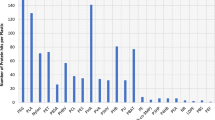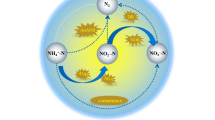Abstract
Elucidation of the different growth states of Ferroplasma species is crucial in understanding the cycling of iron in acid leaching sites. Therefore, a proteomic and biochemical study of anaerobic growth in ‘Ferroplasma acidarmanus’ Fer1 has been carried out. Anaerobic growth in Ferroplasma spp. occurred by coupling oxidation of organic carbon with the reduction of Fe3+; but sulfate, nitrate, sulfite, thiosulfate, and arsenate were not utilized as electron acceptors. Rates of Fe3+ reduction were similar to other acidophilic chemoorganotrophs. Analysis of the ‘F. acidarmanus’ Fer1 proteome by 2-dimensional polyacrylamide gel electrophoresis revealed ten key proteins linked with central metabolic pathways ≥4 fold up-regulated during anaerobic growth. These included proteins putatively identified as associated with the reductive tricarboxylic acid pathway used for anaerobic energy production, and others including a putative flavoprotein involved in electron transport. Inhibition of anaerobic growth and Fe3+ reduction by inhibitors suggests the involvement of electron transport in Fe3+ reduction. This study has increased the knowledge of anaerobic growth in this biotechnologically and environmentally important acidophilic archaeon.





Similar content being viewed by others
Abbreviations
- AMD:
-
Acid mine drainage
- S0 :
-
Elemental sulfur
- RISC:
-
Reduced inorganic sulfur compound
- MSM:
-
Mineral salts medium
- 2D-PAGE:
-
2-Dimensional polyacrylamide gel electrophoresis
- MALDI-TOF:
-
Matrix-assisted laser desorption ionization time-of-flight
- 1D-PAGE:
-
1-Dimensional polyacrylamide gel electrophoresis
- TCA:
-
Tricarboxylic acid
- HQNO:
-
2-Heptyl-4-Hydroxyquinoline N-oxide
References
Altschul SF et al (1997) Gapped BLAST and PSI-BLAST: a new generation of protein database search programs. Nucleic Acids Res 25:3389–3402
Andrews SC, Robinson AK, Rodriguez-Quinones F (2003) Bacterial iron homeostasis. FEMS Microbiol Rev 27:215–237
Baker-Austin C, Dopson M, Wexler M, Sawers G, Bond PL (2005) Molecular insight into extreme copper resistance in the extremophilic archaeon “Ferroplasma acidarmanus” Fer1. Microbiology 151:2637–2646
Brasseur G, Levican G, Bonnefoy V, Holmes D, Jedlicki E, Lemesle-Meunier D (2004) Apparent redundancy of electron transfer pathways via bc 1 complexes and terminal oxidases in the extremophilic chemolithoautotrophic Acidithiobacillus ferrooxidans. Biochim Biophys Acta 1656:114–126
Bridge TAM, Johnson DB (1998) Reduction of soluble iron and reductive dissolution of ferric iron-containing minerals by moderately thermophilic iron-oxidizing bacteria. Appl Environ Microbiol 64:2181–2186
Brierley CL (2001) Bacterial succession in bioheap leaching. Hydrometallurgy 59:249–255
Cecchini G, Schroder I, Gunsalus RP, Maklashina E (2002) Succinate dehydrogenase and fumarate reductase from Escherichia coli. Biochim Biophys Acta Bioenerg 1553:140–157
Dawson MV, Lyle SJ (1990) Spectrophotometric determination of iron and cobalt with ferrozine and dithizone. Talanta 37:1189–1191
Degli Esposti M (1998) Inhibitors of NADH-ubiquinone reductase: an overview. Biochim Biophys Acta Bioenerg 1364:222–235
Dopson M, Baker-Austin C, Bond PL (2004a) First use of 2-dimensional polyacrylamide gel electrophoresis to determine phylogenetic relationships. J Microbiol Methods 58:297–302
Dopson M, Baker-Austin C, Bond PL (2005) Analysis of differential protein expression during growth states of Ferroplasma strains and insights into electron transport for iron oxidation. Microbiology 151:4127–4137
Dopson M, Baker-Austin C, Hind A, Bowman JP, Bond PL (2004b) Characterization of Ferroplasma isolates and Ferroplasma acidarmanus sp. nov., extreme acidophiles from acid mine drainage and industrial bioleaching environments. Appl Environ Microbiol 70:2079–2088
Dopson M, Baker-Austin C, Koppineedi PR, Bond PL (2003) Growth in sulfidic mineral environments: metal resistance mechanisms in acidophilic micro-organisms. Microbiology 149:1959–1970
Dopson M, Lindström EB (1999) Potential role of Thiobacillus caldus in arsenopyrite bioleaching. Appl Environ Microbiol 65:36–40
Edwards KJ, Bond PL, Gihring TM, Banfield JF (2000) An archaeal iron-oxidizing extreme acidophile important in acid mine drainage. Science 287:1796–1799
Golyshina OV et al (2000) Ferroplasma acidiphilum gen. nov., sp. nov., an acidophilic, autotrophic, ferrous-iron-oxidizing, cell-wall-lacking, mesophilic member of the Ferroplasmaceae fam. nov., comprising a distinct lineage of the Archaea. Int J Syst Evol Microbiol 50:997–1006
Golyshina OV, Timmis KN (2005) Ferroplasma and relatives, recently discovered cell wall-lacking archaea making a living in extremely acid, heavy metal-rich environments. Environ Microbiol 7:1277–1288
Hallberg KB, Thomson HEC, Boeselt I, Johnson DB (2001) Aerobic and anaerobic sulfur metabolism by acidophilic bacteria. In: Ciminelli VST, Garcia O Jr (eds) International biohydrometallurgy symposium. Elselvier, Ouro Preto, Brazil, pp 423–431
Hesketh A et al (2002) The GlnD and GlnK homologues of Streptomyces coelicolor A3(2) are functionally dissimilar to their nitrogen regulatory system counterparts from enteric bacteria. Mol Microbiol 46:319–330
Huynen MA, Dandekar T, Bork P (1999) Variation and evolution of the citric-acid cycle: a genomic perspective. Trends Microbiol 7:281–291
Johnson DB, Bridge TAM (2002) Reduction of ferric iron by acidophilic heterotrophic bacteria: evidence for constitutive and inducible enzyme systems in Acidiphilium spp. J Appl Microbiol 92:315–321
Johnson DB, McGinness S (1991) Ferric iron reduction by acidophilic heterotrophic bacteria. Appl Environ Microbiol 57:207–211
Kolthoff JM, Sandell EB (1963) Textbook of quantitative inorganic chemistry. MacMillan Publishing Co., New York
Komorowski L, Verheyen W, Schafer G (2002) The archaeal respiratory supercomplex SoxM from S. acidocaldarius combines features of quinole and cytochrome c oxidases. Biol Chem 383:1791–1799
Kusel K, Dorsch T, Acker G, Stackebrandt E (1999) Microbial reduction of Fe(III) in acidic sediments: isolation of Acidiphilium cryptum JF-5 capable of coupling the reduction of Fe(III) to the oxidation of glucose. Appl Environ Microbiol 65:3633–3640
Kusel K, Roth U, Drake HL (2002) Microbial reduction of Fe(III) in the presence of oxygen under low pH conditions. Environ Microbiol 4:414–421
Lombardo MJ, Bagga D, Miller CG (1991) Mutations in rpoA affect expression of anaerobically regulated genes in Salmonella typhimurium. J Bacteriol 173:7511–7518
Nordstrom DK, Alpers CN, Ptacek CJ, Blowes DW (2000) Negative pH and extremely acidic mine waters from Iron Mountain, California. Environ Sci Technol 34:254–258
Ohmura N, Sasaki K, Matsumoto N, Saiki H (2002) Anaerobic respiration using Fe3+, S0, and H2 in the chemolithoautotrophic bacterium Acidithiobacillus ferrooxidans. J Bacteriol 184:2081–2087
Okibe N, Gericke M, Hallberg KB, Johnson DB (2003) Enumeration and characterization of acidophilic microorganisms isolated from a pilot plant stirred-tank bioleaching operation. Appl Environ Microbiol 69:1936–1943
Pritchard RH, Tempest DW (1982) Growth: cells and populations. In: Mandelstam J, McQuillen K, Dawes I (eds) Biochemistry of bacterial growth, 3rd edn. Blackwell Scientific Publications, Oxford
Richardson DJ (2000) Bacterial respiration: a flexible process for a changing environment. Microbiology 146:551–571
Schröder I, Johnson E, de Vries S (2003) Microbial ferric iron reductases. FEMS Microbiol Rev 27:427–447
Suzuki I (2001) Microbial leaching of metals from sulfide minerals. Biotechnol Adv 19:119–132
Thomas PE, Ryan D, Levin W (1976) An improved staining procedure for the detection of the peroxidase activity of cytochrome P-450 on sodium dodecyl sulfate polyacrylamide gels. Anal Biochem 75:168–176
Tolkatchev D, Yu L, Yu CA (1996) Potential induced redox reactions in mitochondrial and bacterial cytochrome b-c 1 complexes. J Biol Chem 271:12356–12363
Tyson GW et al (2004) Community structure and metabolism through reconstruction of microbial genomes from the environment. Nature 428:37–43
Walt A, Kahn ML (2002) The fixA and fixB genes are necessary for anaerobic carnitine reduction in Escherichia coli. J Bacteriol 184:4044–4047
Acknowledgments
We thank JF Banfield and KJ Edwards for provision of ‘F. acidarmanus’ Fer1 and helpful discussions. DJ Richardson is acknowledged for assistance in interpreting electron transport data. Trypsin digests and MALDI-TOF analysis of excised proteins was carried out at the John Innes Centre, Norwich. The technical assistance of M Maidment and L Flegg was greatly appreciated and R Evans-Gowing is acknowledged for taking the electron micrographs. This work was funded by a BBSRC Research grant.
Author information
Authors and Affiliations
Corresponding author
Additional information
Communicated by G. Antranikian.
Rights and permissions
About this article
Cite this article
Dopson, M., Baker-Austin, C. & Bond, P. Towards determining details of anaerobic growth coupled to ferric iron reduction by the acidophilic archaeon ‘Ferroplasma acidarmanus’ Fer1. Extremophiles 11, 159–168 (2007). https://doi.org/10.1007/s00792-006-0029-y
Received:
Accepted:
Published:
Issue Date:
DOI: https://doi.org/10.1007/s00792-006-0029-y




